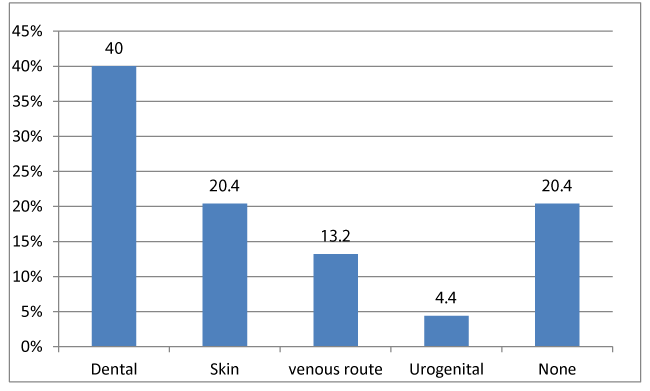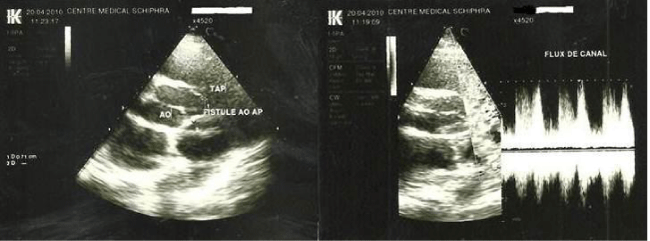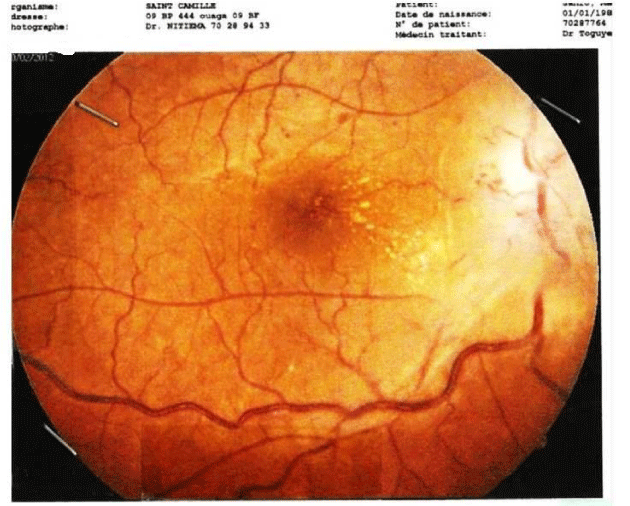Journal of Cardiovascular Medicine and Cardiology
Vascular complications of infective endocarditis in Burkina Faso
Nobila Valentin Yameogo1,2*, S Jean Baptiste Tougouma3, Larissa Justine Kagambega1, Ismaël Diallo4, Georges Rosario Christian Millogo1,2, Koudougou Jonas Kologo1,2, Andre K Samadoulougou1,2 and Patrice Zabsonré1,2
2Training and Research Unit in Health Sciences, University Of Ouagadougou, 03 PB 7021 Ouagadougou 03, Burkina Faso
3Higher Institute of Health Sciences, Polytechnic University of Bobo-Dioulasso, 01 PB 1091 Bobo-Dioulasso 01, Burkina Faso
4Internal Medicine department of Yalgado Ouedraogo University Hospital, 03 PB 7022 Ouagadougou 03, Burkina Faso
Cite this as
Yameogo NV, Baptiste Tougouma SJ, Kagambega LJ, Diallo I, Christian Millogo GR, et al. (2018) Vascular complications of infective endocarditis in Burkina Faso. J Cardiovasc Med Cardiol 5(3): 020-023. DOI: 10.17352/2455-2976.000065Introduction: Vascular complications of infective endocarditis are frequent and severe. The aim of this study was to clarify the epidemiological, clinical and prognostic characteristics of these vascular damages and determine their associated factors.
Patients and methods: We performed a descriptive cross-sectional study from 1 January 2013 to 31 December 2016 on patients admitted to the cardiology department of Yalgado Ouedraogo teaching Hospital for infective endocarditis and vascular complications recorded. The diagnosis of infective endocarditis was established on the basis of modified Dukef.
Results: We recorded a total of 44 infective endocarditis. Vascular complications were found in 10 cases (22.7%) including 6 women and 4 men. The average age of patients was 36.7 years with extremes of 23 and 74 years. In total, seventeen vascular complications were recorded. They were dominated by neurological (7 cases) and acute limb ischemia (4 cases). The average time between the installation of the fever and the occurrence of vascular complications was 41.6 ± 6.5 days. Factors associated with embolization were reaching the mitral valve (RR = 2.5, p = 0.047), infection by Staphylococcus aureus (RR = 1.8, p = 0.022), the size of the upper vegetation 10 mm (RR = 1.8, p = 0.046), the mobility of the vegetation (RR = 1.5, p = 0.048) and late turning on appropriate antibiotics (dual antibiotic beyond 2 weeks after the start of fever) (RR = 1.4; p = 0.038). Mortality was heavy (60%) and neurological involvement was a poor prognostic factor.
Conclusion: Vascular complications are frequent in infective endocarditis and are dominated by neurovascular damage. The factors associated with these complications are related to the characteristics of endocarditis. Neurological involvement is a poor prognostic factor.
Introduction
Vascular complication during infectious endocarditis is defined by the occurrence of embolic and / or haemorrhagic attacks during infectious endocarditis. They are frequent, with poor prognosis [1]. The primum movens in these alterations remain vegetation, which is a septic emboli. The prevalence of these complications is poorly known. They aggravate the mortality which is already raised at 16% [2], and 37% at one year [3]. The purpose of this work was to describe the epidemiological, clinical, and prognostic features of vascular complications during infectious endocarditis and to determine the factors associated with these complications
Patients and methods
We conducted a descriptive cross-sectional study from January 1, 2013 to December 31, 2016 including patients admitted to the cardiology department of Yalgado Ouédraogo University Hospital for infectious endocarditis.
Diagnosis of endocarditis was based on modified Duke criteria [4]. Patients who had one or more vascular complications were then selected excluding those who were in atrial fibrillation and those who were on anticoagulant therapy. Studied parameters were socio-demographic, (age, sex, occupation, level of study, geographical origin and socio-economic level), clinical (date of onset of fever, treatment already administered, door of entry, arterial pressure, cardiac frequency, respiratory frequency, neurological deficit, sign of acute limb ischemia, mesenteric ischemia, splenic involvement, visual disturbance and arteriovenous fistula), bacteriological (blood cultures), electrocardiographic (arrhythmias, ST elevated segment acute coronary syndrome) and echocardiography (vegetations’ study, study of endocardial damage). Other examinations were performed according to the vascular complications: cerebral CT, arterial Doppler ultrasound, pulmonary angioscan and ocular arteriography.
The following complications were investigated: neurovascular, arterial limb, myocardial infarction, arteriovenous fistula, renal and splenic infarction, mesenteric ischemia, and septic pulmonary embolism.
We have empirically assumed that contemporary ischemic events of endocarditis were of septic embolic origin (endocarditis-related).
The diagnostic criteria for complications were as follow:
- For acute coronary syndrome, it was angina chest pain, ST segment elevation in at least two contiguous leads of the same coronary territory, and troponin increase.
- For acute limb ischemia, the diagnostic criteria were clinical semiology of acute limb ischemia and arterial Doppler discontinuation or alteration of flow.
- For acute septic pulmonary embolism: symptoms of pulmonary embolism with in the pulmonary angio-CT, the detection of an embolus in the arterial pulmonary tree.
- Renal and splenic infarction was retained on the basis of abdominal CT findings.
- The neurovascular complications were sought after on clinical examination but especially on cerebral CT (ischemic infarction, haemorrhage, aneurysms and abscess).
Results
General data
During the study period, we included 44 cases of infectious endocarditis, of which 10 had at least one vascular complication. The frequency of these complications was thus of 22.7%. The mean age was 38.7 ± 5.8 years (18 and 74 years) and the sex ratio was 0.76. The socio-economic level was low in more than two-thirds of the cases (86.4). The remaining patients had an average socio-economic level (13.6%). More than half of the patients lived in suburban areas (77.3%). HIV infection was found in 2 cases, sickle cell disease in 3 cases and diabetes and chronic obstructive pulmonary disease in 1 case respectively.
Endocarditis characteristics
Subacute endocarditis occurred in 88.6% of cases and acute in other cases. The entryway was dominated by the dental (41%) and cutaneous (20.4%) pathways. No gateway could be demonstrated in 20.4% of cases. (Figure 1). shows the distribution of the entrance doors. Only 4 of patients were known as suffering from heart disease. Echocardiographic examination found as underlying heart disease a rheumatic valvular heart disease in the majority of cases (70.4%), valvular prosthesis and dilated cardiomyopathy in 9.1% of cases respectively, and peripartum cardiomyopathy in 4.5 %.
Vegetations were found in all cases. They sat on the mitral valve in 58.6% of cases, the aorta in 25% of cases, the tricuspid in 18.2% of cases and the pulmonary in 9.1% of cases. Multiple locations were found in 9.1% of cases. Vegetations were mobile in 27.3% of cases. The average of the largest diameter of the vegetations was 6.4 ± 4.1 mm (extremes of 1.6 and 22 mm). A diameter greater than 10 mm was found in 13 patients (29.5%). Valvular insufficiency was found in all patients. The associated lesions were divided into mitral perforations (3 cases), cord rupture (2 cases), aortic abscess and aortopulmonary fistula in 1 case respectively.
Blood cultures were positive in 45.4% of cases. The identified organisms were Staphylococcus aureus (9 cases), Streptococcus a-viridans (5 cases), Staphylococcus sp (3 cases) and Citobacter spp (3 cases).
Treatment consisted of a double probabilistic antibiotic therapy and secondarily rehabilitated according to blood cultures data. No surgery was performed.
Vascular complications
Vascular complications were found in 10 patients, a frequency of 22.7%. The mean age of patients with a vascular complication was 36.7 ± 5.7 years (range, 23 to 74 years) and sex ratio was 0.6. The number of vascular complications was 1 in 4 patients, 2 in 5 patients and 3 in 1 patient (a total of 17 vascular complications).
Patients’ characteristics: They were all low socioeconomic level. The infectious syndrome was found in all patients. Global heart failure was found in 3 patients. All patients received antibiotic treatment (10 cases, 8 oral and 2 parenteral), 10 antimalarials (5 parenteral and 5 enteral), and 4 patients treated with Nonsteroidal anti-inflammatory drugs (oral). Vascular complication was the circumstance of diagnosis of endocarditis in 3 cases. Hemiplegia was found in 5 cases, aphasia in 2 cases, pulse abolition in 3 cases, Durozier’s femoris murmur in 1 case, surgical abdomen in 2 cases, acute blindness in 1 case, and thoracic pain in 3 cases.
Types of vascular complications:
• Cerebrovascular complications
They were found in 7 cases. The clinical signs besides the infectious syndrome were dominated by the motor deficit (5 cases) the speech disorder (1 case) and the coma (1 case). It showed ischemic stroke in 6 cases and haemorrhagic stroke in 1 case.
• The acute ischemic limb
It was found in 4 cases. The symptomatology was typical with acute pain, absence of pulse, coldness of the limb, paleness and functional impotence in 2 cases. In the other two cases, there were no signs. Arterial Doppler ultrasonography found partial thrombosis of the left popliteus in 2 cases, complete thrombosis of the posterior tibialis in 1 case, and partial iliac thrombosis in 1 case.
• Splenic infarction
It was objectified in 2 cases. The clinical manifestation was left flank pain in all cases. The diagnosis was confirmed on the abdominal CT scan.
• Arteriovenous fistula
It was highlighted in 1 case. The clinical symptomatology was a continuous murmur simulating an arterial duct persistence. Cardiac echography and Doppler found an aortic defect with a pulmonary artery aortic shunt just upstream of the aortic root (Figure 2).
• Retinal thrombosis
Found in one case, it was a sudden loss of contemporary visual acuity of endocarditis; retinal arteriography showed thrombosis of the central artery of the retina (Figure 3).
• Pulmonary embolism
The clinical signs were dominated by dyspnea, cough and haemoptysis. The diagnosis was confirmed by thoracic CT angiography, which revealed proximal thrombosis of the right pulmonary artery. It was found in 1 case
• Myocardial infarction
This was a clinical picture of persistent chest pain with ST segment elevation in ECG and in biology a significant increase in markers of myocardial necrosis. It has been highlighted in a subject of 18 years.
Endocarditis embolization factors: In multivariate analysis, factors associated with embolization were mitral valve disease (RR = 2.5, p = 0.047), Staphylococcus aureus infection (RR = 1.8, p = 0.022), vegetation greater than 10 mm (RR = 1.8, p = 0.046), vegetative mobility (RR = 1.5, p = 0.048) and late application with adequate antibiotics (double antibiotic therapy beyond 2 weeks after the onset of fever) (RR = 1.4, p = 0.038).
Treatment: It consisted essentially of antibiotic initially probabilistic and secondarily adapted to the antibiogram as appropriate. No instrumental or surgical treatment was performed.
Evolution: The evolution was marked by the occurrence of 6 deaths (60%). The causes of death were stroke, myocardial infarction, and pulmonary embolism. The deaths were directly related to the vascular complication.
Discussion
This work has some limitations, especially the small size of the sample which does not allow to generalize our results because of the statistical weakness. We considered only symptomatic forms; this may underestimate the frequency of vascular complications. Nevertheless, this work has the merit of being one of the few in Black Africa to dwell on the vascular complications of endocarditis and to determine the associated factors. It shows that vascular complications are numerous during endocarditis (22.7%). The actual frequency of these vascular complications is however difficult to specify because many of them are asymptomatic and others only objectified in post mortem. In addition, the asymptomatic forms would reach 20% of the report of certain authors [5]. Nevertheless, in both African and European studies, these complications reach 13% to 49% [6]. Vascular complication is sometimes indicative of infectious endocarditis. In our study, 3 cases were recorded. All authors agree on the early occurrence of these complications and their revealing character [7,8]. In the Zarzur study [7], more than half of the complications (54%) occurred before the end of the second week of antibiotic therapy.
- The neurological complications are the most frequent vascular complications of infectious endocarditis with a frequency of 10 to 40% according to the studies [9]. They were also the most frequent in our study with a similar frequency (41.2%). It is essentially ischemic in the majority of cases.
- Arterial involvement of the lower limbs rank second (23.5%). after the neurological attacks. They occurred in our study as acute limb ischemia. Their frequency varies from 20 to 30% in the literature [10]. It most often affects the lower limbs [7].
- Coronary complications are very rare. But necropsy studies show that their frequency reaches 60% [11]. The clinical presentation is a myocardial infarction as it was in our study. Its management is difficult and delicate due to hemodynamic disturbances and septic state [12].
- Splenic infarction is a frequent complication of infective endocarditis of the left heart. Its frequency reaches 40%. In our study, it was found in 1 case.
- Septic pulmonary embolism is frequent in endocarditis of the right heart especially when the vegetation sits on the tricuspid valve. The clinical presentation is febrile chest pain with pneumonitis. The diagnosis is made at thoracic angioTDM. The prognosis depends on the virulence of the germ and its sensitivity to antibiotics [13].
The factors associated with septic embolizations are variously appreciated in the literature. Thuny F et al. in their study identified size (greater than 10 mm), mobility, and mitral seat as factors associated with septic embolization [14]. For Sonneville R et al. Staphylococcal infection is an embolization factor [15,16]. All these factors were found in our study but also the adequate late management.
Conclusion
This work shows that vascular complications are common during infectious endocarditis. These complications are mainly dominated by the neurological complications of which ischemic stroke is the most common. Factors associated with these vascular complications are mitral valve involvement, Staphylococcal infection, vegetation size greater than 10 mm, vegetative mobility and late initiation with adequate antibiotics (dual antibiotic therapy beyond 2 weeks after the onset of fever). The prognosis of these endocarditis complicated by arterial embolisms is reserved (60% mortality) and the neurological involvement is a factor of poor prognosis.
These findings challenge medical staff and policymakers in the urgency of preventing infectious endocarditis, creating centers of competence and raising awareness among the population for faster consultation in a health center.
- Baddour LM, Wilson WR, Bayer AS, Fowler VG, Bolger AF, et al. (2005) Infective endocarditis: diagnosis, antimicrobial therapy, and management of complications: a statement for healthcare professionals from the American Heart Association; endorsed by the Infectious Diseases Society of America. Circulation 111: 394-434. Link: https://tinyurl.com/ya3l8o7a
- Hoen B, Alla F, Selton-Suty C, Béguinot I, Bouvet A, et al. (2002) Association pour l’étude et la prévention de l’endocardite infectieuse (AEPEI) Study Group. Changing profile of infective endocarditis: results of a 1-year survery in France. JAMA 288: 75-81. Link: https://tinyurl.com/ybe628oz
- Cabell CH, Jollis JG, Peterson GE, Corey GR, Anderson DJ, et al. (2002) Changing patient characteristics and the effect on mortality in endocarditis. Arch Intern Med 162: 90-94. Link: https://tinyurl.com/y9ldr7rb
- Li JS, Sexton DJ, Mick N, Nettles R, Fowler VG, et al. (2000) Proposed modifications to the Duke criteria for diagnosis of infective endocarditis. Clin Infect Dis 30: 633-638. Link: https://tinyurl.com/ycc5offw
- Di Salvo G, Habib G, Pergola V, Avierinos JF, Philip E, et al. (2001) Echocardiography predicts embolic events in infective endocarditis. J Am Coll Cardiol 31: 1069-1076. Link: https://tinyurl.com/y9vhyp3t
- Habib G (2003) Embolic risk in subacute bacterial endocarditis: role of transesophageal echocardiography. Curr Cardiol Rep 5: 129-136. Link: https://tinyurl.com/y8cyqtlz
- Zarzur J, Amri R, Cherradi R, Housni A, Balafrej K, et al. (2002) Les complications vasculaires de l’endocardite infectieuse. Etude rétrospective de 18 cas. J Mal Vasc 27: 82-87. Link: https://tinyurl.com/ya9r5vbm
- Paschalis C, Pugsley W, John R, Harrison MJ (1990) Rate of cerebral embolic events in relation to antibiotic and anticoagulant therapy in patients with bacterial endocarditis. Eur Neurol 30: 87-89. Link: https://tinyurl.com/ycxwjj6r
- Thuny F, Di Salvo G, Belliard O, Avierinos JF, Pergola V, et al. (2005) Risk of embolism and death in infective endocarditis: prognostic value of echocardiography: a prospective multicenter study. Circulation 112: 69-75. Link: https://tinyurl.com/y72ue7ad
- Sonneville R, Mirabel M, Hajage D, Tubach F, Vignon P, et al. (2011) Neurologic complications and outcomes of infective endocarditis in critically ill patients: the ENDOcardite en REAnimation prospective multicenter study. Crit Care Med 39: 1474-1481. Link: https://tinyurl.com/yd9jo9ct
- Sonneville R, Klein I, Bouadma L, Mourviller B, Regnier B, et al. (2009) Complications neurologiques des endocardites infectieuses. Réanimation 18: 547-555. Link: https://tinyurl.com/ybkxuoty
- Duval X, Laissy JP, Leport C (2002) Complications neurologiques des endocardites infectieuses: épidémiologie, diagnostic, prise en charge, pronostic. Correspondance en neurologie vasculaire 4: 26-29. Link: https://tinyurl.com/y8c6f2pf
- Klein M, Wang A (1989) Systemic embolization in hospital treated infective endocarditis at a tertiary medical center: importance of antibiotic therapy. Ciculation 57: 2306-2312. Link: https://tinyurl.com/ybrnyx6f
- Loire R, Tabib A (1985) Coronary embolism. A propos of 61 anatomo-clinical cases. Arch Mal Coeur Vaiss 78: 821-827. Link: https://tinyurl.com/yd6gzcjv
- Donal E, Coisne D, Valy Y, Allal J, Christaens L, et al. (1999) Infarctus du myocarde par embole septique au cours d’une endocartite mitrale. Arch Mal Coeur 92: 253-257. Link: https://tinyurl.com/yao9jb73
- Rouveix E, Witchitz S, Bouvet E, Friedlander G, Wolff M, et al. (1984) Tricuspid infective endocarditis: 56 cases. Eur Heart 5: 111-115. Link: https://tinyurl.com/y8mg4w3u

Article Alerts
Subscribe to our articles alerts and stay tuned.
 This work is licensed under a Creative Commons Attribution 4.0 International License.
This work is licensed under a Creative Commons Attribution 4.0 International License.



 Save to Mendeley
Save to Mendeley
